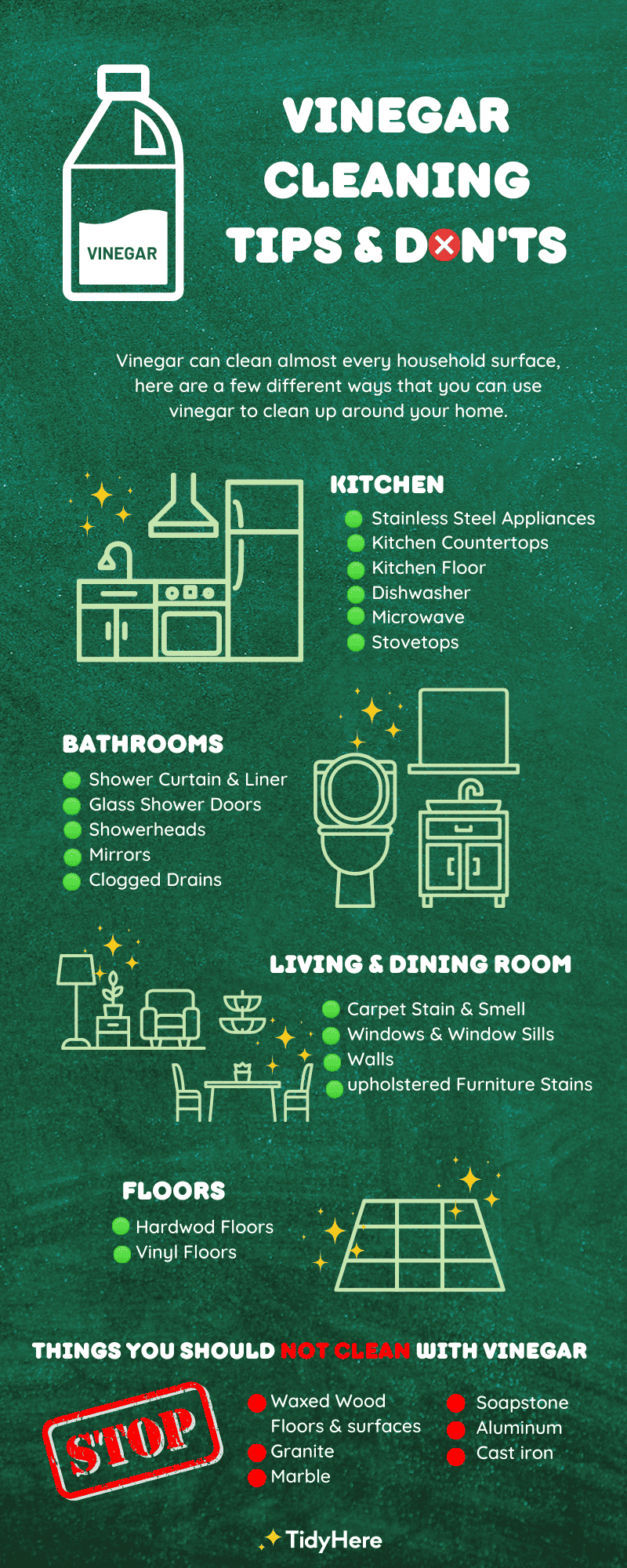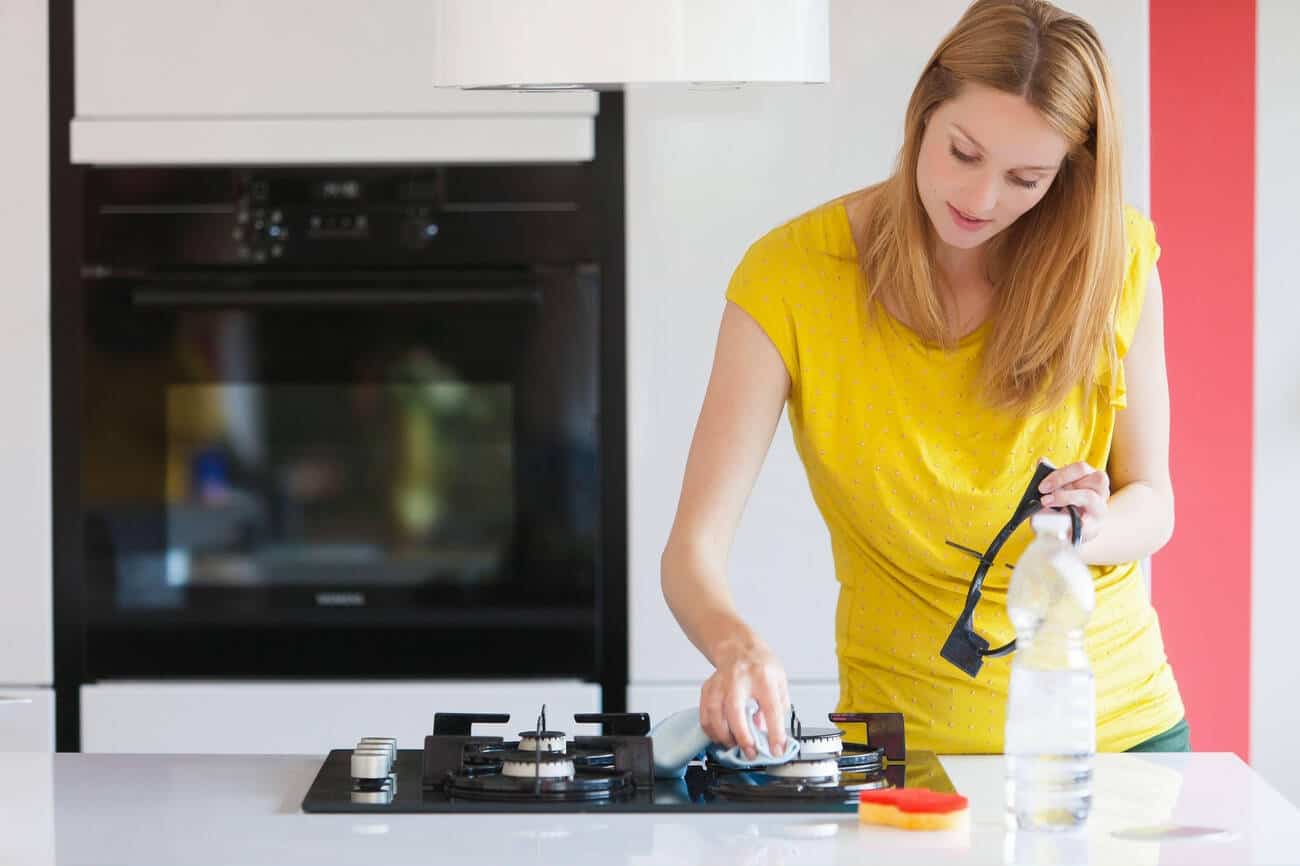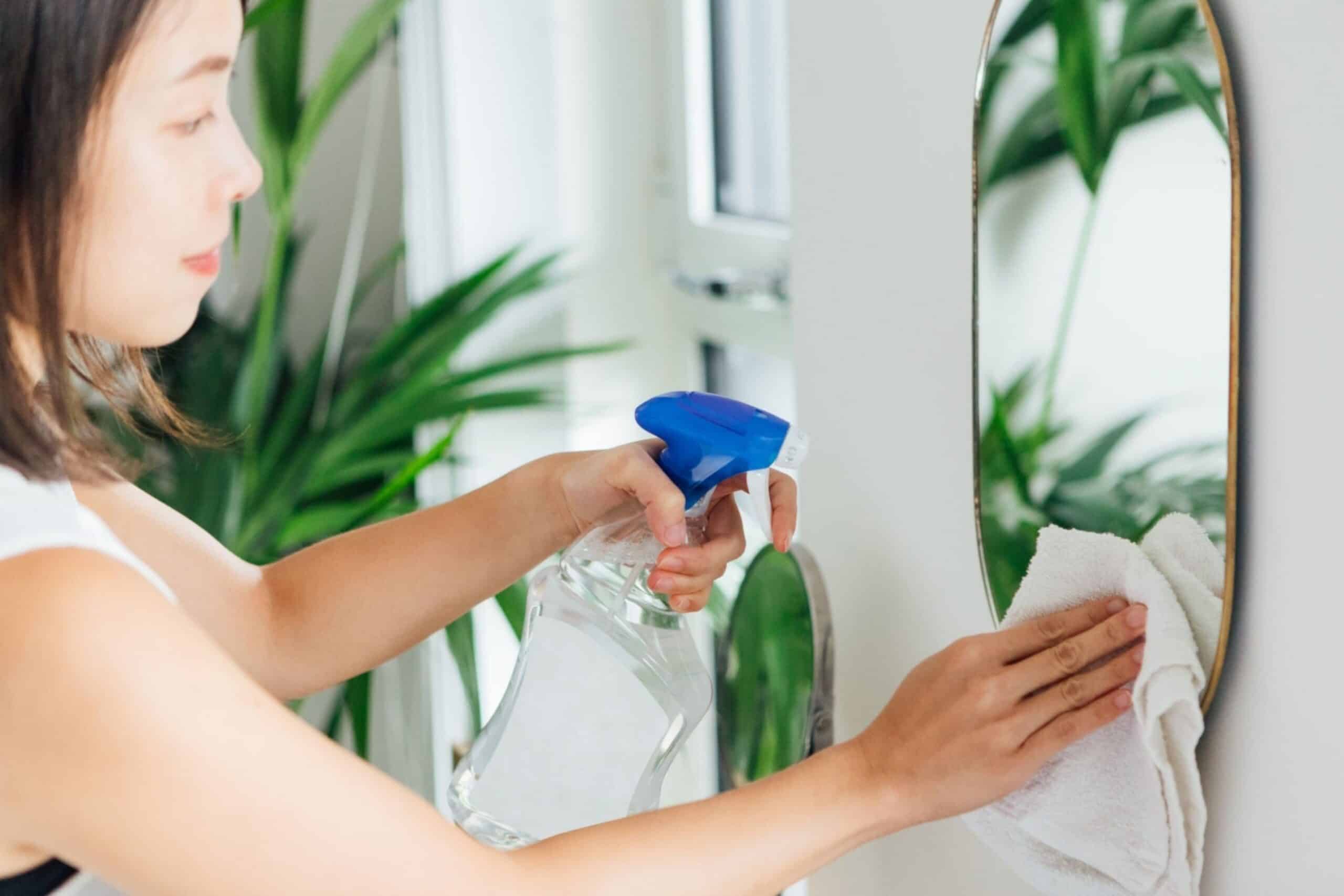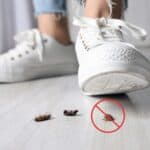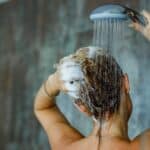If you know us, you know how much we love and swear by cleaning with vinegar. We keep distilled white vinegar in our cleaning arsenal pretty regularly, because it only has about 5 percent acidity, so it’s on-par with other common cleaning products.
And of course, it’s also super affordable and accessible, so you can put your hard earned money to use on other cleaning essentials. Here are a few different ways that you can use vinegar to clean up around your home.
How to Clean Your Kitchen with Vinegar
Stainless Steel Appliances
Pretreat your stainless steel appliances by misting some white vinegar directly onto the appliance and simply wiping it clean with a dry microfiber rag. This little action can actually prevent grime, grease, and sticky fingerprints from building up and leaving streaks and marks on your stainless steel dishwasher door, fridge, microwave, toaster oven, etc.
Kitchen Countertops
✨ Keeping a spray bottle filled half with vinegar and half with water in your kitchen is one of the best favors you can do for yourself. Whenever you need to clean up food residue or spills, or just to disinfect, your trusty vinegar spray will do the trick.
✨ You should avoid using vinegar on countertops that are granite or marble, since the acidic vinegar will cause damage like permanent etch marks.
Kitchen Floor
Most kitchen floors are vinyl or linoleum, which can easily be mopped up with the same diluted vinegar solution that you can use on your countertops. Mix some vinegar in your mop bucket with water or in your spray mop’s container, and use the solution around your floor, working to mop from the inside out.
Microwave
✨ For microwave interiors, place a bowl of vinegar in the microwave for a minute on high. The steaming vinegar will help to dislodge any food stains and splatters, so you can wipe them off with a damp rag. Plus, the vinegar will also help if your microwave is hanging onto any unpleasant smells.
Dishwasher
✨ For stainless steel dishwasher doors, much like your refrigerators, you can spray some vinegar straight onto the exterior of the door, and give it a good wipe with a microfiber cloth.
✨ You should avoid using vinegar to clean the interior of your dishwasher’s door because its acidity can actually deteriorate your dishwasher’s seals, which are crucial for keeping the steam and water in.
✨ For dishwasher smells, you can run your empty dishwasher with a bowl of white vinegar placed on the top rack. The vinegar will heat and steam during the cycle and help to neutralize any lingering smells coming from your dishwasher.
✨ Vinegar will also help loosen and remove any gunk and grease stuck to the dishwasher’s interior walls or door. Remember to check your dishwasher filter, and give that a good scrub as well.
Stovetops
✨ For glass stovetops, spray some distilled white vinegar all over your stovetop’s surface. If there are baked on food stains, add a bit of baking soda on top of the vinegar and allow the combo to fizz and bubble. Lay a hot, wet towel over the mixture and let it sit for about 15 minutes before removing it, and then rinse everything with a clean, damp sponge.
✨ For electric stovetops, remove grease any catchers and heating coils and then spray your trusty distilled vinegar solution around the surface of the stove, let it sit for about 5 minutes and wipe away with a clean, wet rag.
✨ For gas stovetops, be sure to remove the grills. Then spray distilled vinegar solution all over the stove, let it sit for about 5 minutes and wipe away with a clean, wet rag.
How to Clean Your Bathroom with Vinegar
Shower Curtain & Liner
✨ You can treat your shower curtains to prevent mold and mildew growth by running them through the was with ¼ cup of white vinegar. Remember to use a cold or warm cycle, so as to not melt the shower curtain.
✨ Neutralize and treat mildew by spraying your shower curtain and liner with a vinegar and warm water solution regularly. This could be about once a week or so, depending how humid your bathroom gets.
Showerheads
✨ To clean your showerhead, simply remove it and soak it in a bucket or bowl of white vinegar overnight. Vinegar will help to dissolve any mineral buildup that might be blocking the water stream and get rid of hard water spots.
✨ Scrub the showerhead with a soft-bristled scrub brush or old toothbrush to make sure the is clear and unclogged. Rinse the showerhead with some hot water to get rid of any vinegar residue.
Sinks & Countertops
Grab your bottle of diluted white vinegar to spray down and wipe off bathroom countertops and sinks to clean up any makeup residue and toothpaste spatter, as well as disinfect the surface.
Mirrors
Again, use your DIY glass cleaning solution of ¼ cup of white vinegar and 2 cups of warm water, and use this on the mirror rather than glass cleaner for a more effective clean and streak-free finish.
Glass Shower Doors
✨ You can make a DIY glass cleaner by mixing ¼ cup of white vinegar and 2 cups of warm water, and use this rather than regular glass cleaner. Let the vinegar sit on the shower doors for about 30 minutes before wiping it off with hot water and a clean microfiber rag.
✨If your shower doors are particularly scummy, you can prewash them with a few drops of dish soap like Dawn mixed with 2 cups of warm water to treat any grime before using your vinegar wash.
Clogged Drains
To unclog bathroom drains, start by pouring a pot of boiling water down the drain to loosen up any gunk. Next, add about 1 cup of baking soda followed by 1 cup of white vinegar. Wait about 5–10 minutes while the combo fizzes, then finish by flushing the drain with more boiling water.
How to Clean Your Living and Dining Rooms with Vinegar
Removing Stains & Smells from Carpet
✨ Mix a solution of 1 cup vinegar and in a spray bottle and lightly mist the offending carpet. Let the solution air dry and repeat this process if any smells remain.
✨ For super stinky carpets, sprinkle some baking soda onto the area, and let that sit overnight. Vacuum up the baking soda in the morning, then spray the carpet with your vinegar spray to finish up.
Windows and Windowsills
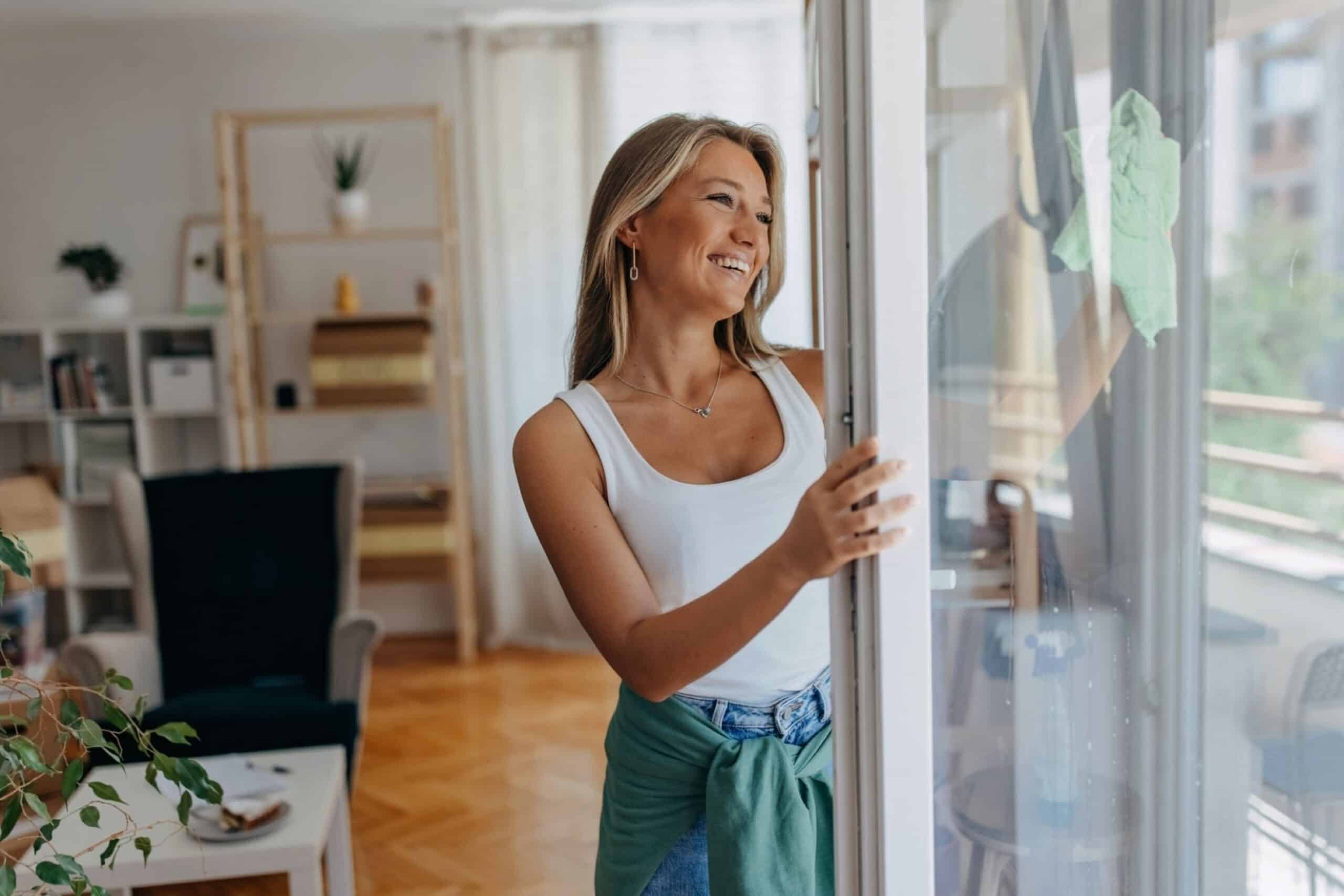
✨ You can lightly mist your fabric curtains or drapes with a diluted vinegar spray to neutralize any stubborn and lingering smells, like smoke or mildew.
Walls
✨ You can use a dish soap like Dawn and warm water to clean your walls if they’re looking a bit dusty and dull. If you’re dealing with walls covered in grease stains or musty smells you’re trying to get rid of, the vinegar solution below should do the trick.
✨ Mix ½ cup of vinegar and 2 cups of warm water in a spray bottle, and apply a light mist on the wall. Let the solution to sit for a few minutes, then wipe it off with a soft sponge. Rinse the walls with a clean, damp (not soaked!) microfiber cloth to remove any vinegar residue and let them air dry.
Treating Stains on Upholstered Furniture
You can spot treat stains on your fabric or upholstered furniture with a vinegar and baking soda mixture. Diluted vinegar is a great odor neutralizer when lightly misted onto upholstered furniture, plus that pungent vinegar scent dissipates quickly, leaving your upholstered furniture scent-free.
How to Clean Your Floors with Vinegar
Hardwood Floors
You can clean your sealed hardwood floors by mixing ½ cup of white vinegar with 1 gallon warm water, and applying this to your floors with a microfiber mop about once a week. Avoid heavily saturating your hardwood floors with the solution because too much water can cause permanent damage and warping on most wood floors.
Vinyl is a super hearty material and can handle higher acidity cleaning solutions like vinegar, so you can actually use regular undiluted white vinegar to clean and disinfect your vinyl floors.
Things You Should Never Clean with Vinegar
Vinegar is awesome for cleaning most things, but there are also many materials that it can damage, due to its high acidity levels. Never, ever clean the following surfaces with vinegar otherwise you will risk ruining the finish, causing etching or corroding metal:
✨ Waxed wood floors and surfaces
✨ Granite
✨ Marble
✨ Soapstone
✨ Aluminum
✨ Cast iron
For more DIY cleaning solutions, check out our blog to find a wide range of helpful topics and guides. Contact us today to find out how we can help you keep your home looking its best all year long.
 Recurring Cleaning
Recurring Cleaning Move In / Out Cleaning
Move In / Out Cleaning Office Cleaning
Office Cleaning Housekeeping
Housekeeping Post Construction Cleaning
Post Construction Cleaning Green Cleaning
Green Cleaning Home Organization
Home Organization Deep Cleaning
Deep Cleaning Oven Cleaning
Oven Cleaning Airbnb Cleaning
Airbnb Cleaning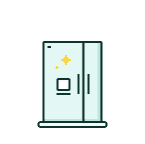 Refrigerator Cleaning
Refrigerator Cleaning
